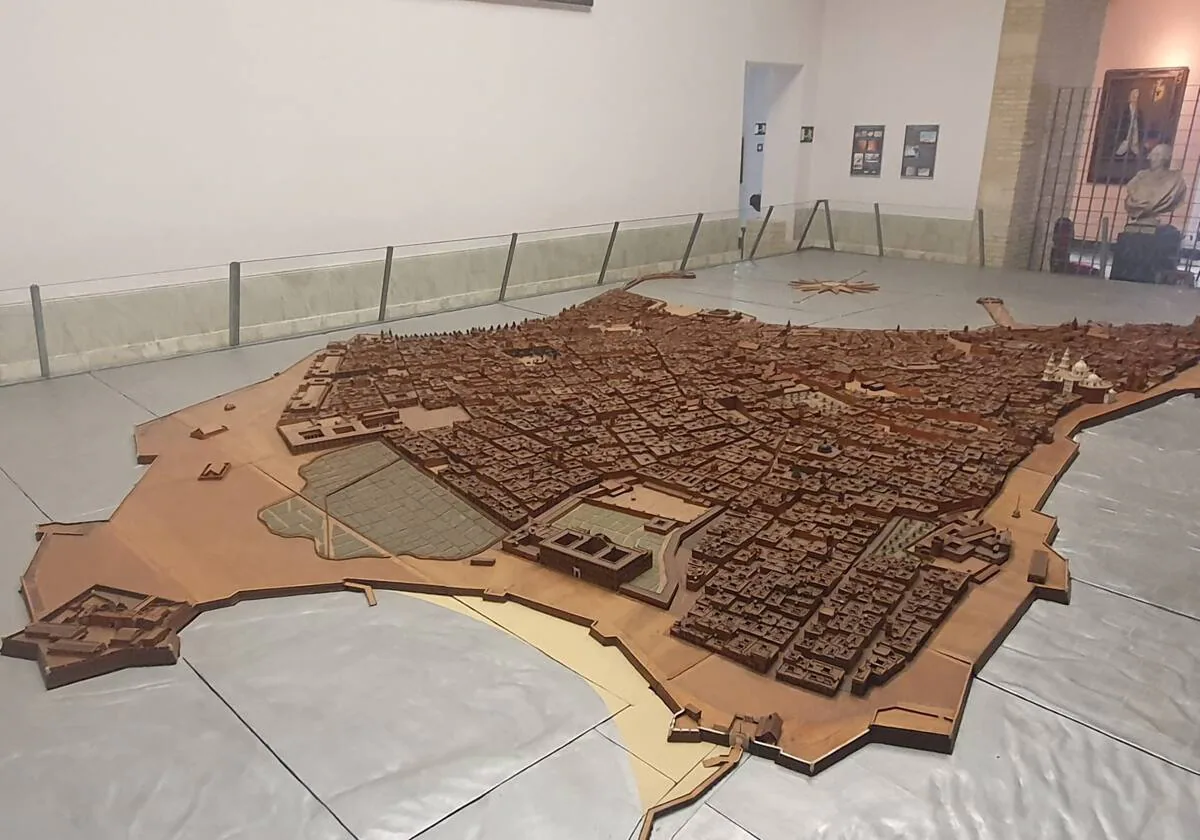Cleaning and conservation work on unique cork model of Cadiz city goes on show to public
The restorer Pedro Macías will dismantle the 350 pieces, many of which will be exhibited in the Museo de las Cortes in five thematic blocks spread over different dates until 3 May
Beatriz Estévez
Cadiz
Wednesday, 3 April 2024, 21:40
Cadiz in all its 18th-century splendour will once again be seen now that cleaning and conservation work has commenced on the cork model of the city, a unique object in Spain, which painstakingly reflects what it was like in 1779 .
This relief model, located in the Museum of Las Cortes, is undergoing maintenance work carried out by the restorer Pedro Macías until 16 May. The novelty this time around is that the public will be able to witness the work as it happens. This was announced in early March by the provincial delegate for Culture, Maite González, while visiting the museum alongside the restorer Macías and Fátima Salaverri, museum director.
"For the first time, right here in Museum of Las Cortes, the visiting public will be able to see for themselves the cleaning and conservation work carried out on this model, and they will also be able to see how it is taken apart and the layout of the whole schematic for this restoration and conservation work".
Thanks to this access as the entire model is dismantled, the public will really get to see the innards of this unique and historical work, taking a close look at the foundations and all that formed Cadiz, getting to know the layout of the streets, the spaces where blocks of houses are packed together as well as the uneven layout of the terrain. Another curious fact is that the 25 square metres of the model's surface area include 350 detachable pieces grouped into 305 blocks .
With so much to take in, it was decided to place many of the pieces into an exhibition divided into five blocks spread over different dates. As the Culture delegate announced: "On the occasion of this work we have considered it appropriate to hold an exhibition of the most iconic buildings of this historic asset, which will allow us to see these pieces up close for the first time" .
The exhibition opened on 19 March, the date commemorating the promulgation of the 1812 Constitution (of the Spanish Monarchy) in Cadiz, and it runs until 3 May .
To this end, the Museum of Las Cortes will operate "a live-action format" while the restorer carries out the task. The five different themes are as follows:
1- The spaces related to the Constitution of 1812, which were on display 19-27 March. The pieces on display were: Oratorio de San Felipe Neri (public-speaking hall used for government and monarchy matters), the church square for St Anthony, Cadiz Cathedral, another church (Iglesia del Carmen), Customs House (Aduana), the hospice and the Women's Hospital.
2- Lookout Towers, from 2 to 8 April. The pieces on display include Recaño Palace, Tavira Tower, the House of the Four Towers, the House of the Five Towers and other buildings with lookout towers amusingly named as 'armchair-style' as the towers are protected by terraces.
3- Places of interest along the city walls, from 10 to 16 April. This collection includes where the land meets up with ramparts and other fortifications to city walls such as the Bastion of San Roque and the Bastion of Santa Elena, San Sebastián Castle, Santa Catalina Castle and one of the city gates, Puerta del Mar.
4- Religious buildings , from 18 to 24 April, comprising Los Descalzos convent, the church and convent of San Francisco and the church of Santa Cruz (the Holy Cross).
5- The most symbolic buildings, from 26 April to 3 May. This part of the exhibition will include the Town Hall, the church of San Juan de Dios with the chapel of Nuestra Señora de El Pópulo, the Engineering Pavilion, Castillo de la Villa (castle) and Model Building Number 245 (of special interest because it has some text transcribed in pencil on its base by the team that created the model figure, now with a protective cover in acetate).
All these mini-exhibitions can be visited from 9am to 2.30pm Monday to Friday and Friday evenings only from 6pm to 8pm.
"We hope that this initiative will be to everyone's liking. It is an opportunity that we have here for the very first time. It's a live job and a moving exhibition that´s very enriching," stated an enthusiastic Maite González.
She also pointed out that, once the cleaning and conservation work is complete, Pedro Macías will give a visual talk on the work undertaken. No date has yet been set for this proposal.
Details of the work to be carried out:
- Dismantling of all model buildings, perimeter platforms and wind rose for a thorough cleaning to remove accumulated dust.
- Checking of each element for damage and reuniting any parts that have become detached.
- Re-touching the coat of varnish and applying a protective topcoat where required including the wind rose (a tool to measure wind direction).
- Cleaning of the silvery surface of the sea, removal of any dust and re-touching the silver where necessary.
- Surface treatment of all wood pieces for protection from, and prevention of, insect invasion.
- Preservation treatment of all wood panels on both sides.
- Removal of the name-plaque from its spot in the middle of the sea to clean and revamp the lettering that is currently illegible.
- Re-assembly of the entire model.
Wooden platforms are being used to place over the parts being worked on. Thus the restorer can remove items from the overall model, piece by piece, without damaging the silver sea by stepping on it. These protective platforms will be stored at the museum for future use.
The total cost of the work is 4,961 euros.
